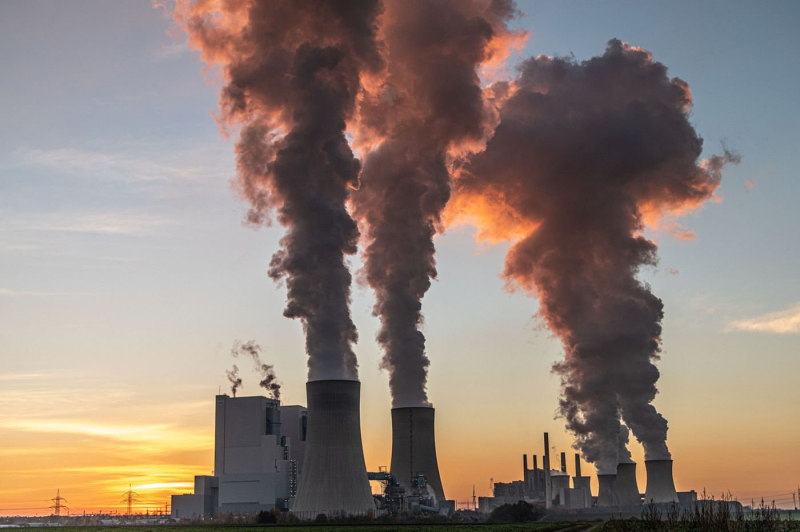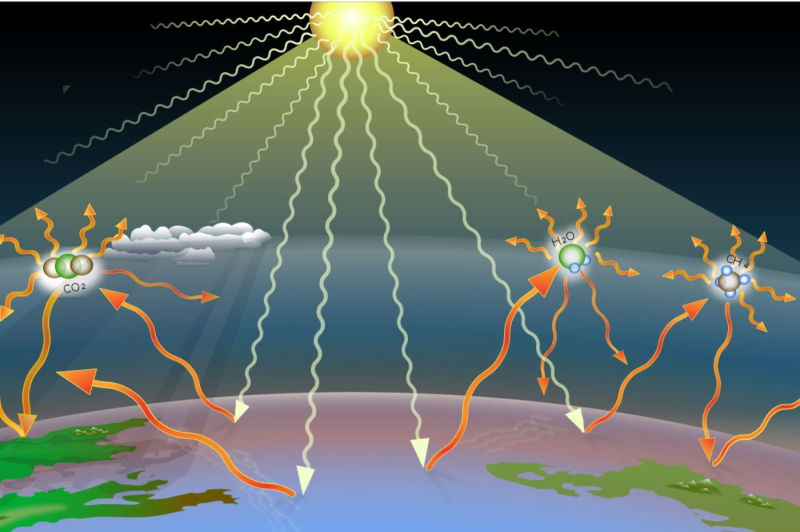
© catazul/pixabay
The ecological question often revolves around the notion of “greenhouse gases” (GES). This term comes up almost every day in the news, but do we really know what a greenhouse gas is? What is the scientific definition behind this “portmanteau word”? And above all, what effects do they really have on the planet and the climate?
To understand the impact of greenhouse gases, we must start by defining them. By doing a little Google search, you quickly come across the website of the Ministry of Ecological Transition. The latter explains that a “greenhouse gas” is “ a gas present in the atmosphere which retains part of the heat received. ”
In short, the GES are gases, invisible and painless, which, due to their chemical composition, are capable of retaining heat better than ambient air. Naturally, the Earth's atmosphere is made up of two greenhouse gases, water vapor and carbon dioxide.
Their level has fluctuated over millions of years, giving the Earth the face we know today. Without these greenhouse gases, the surface temperature would be -15°C on average. They are therefore essential for the development of life and the presence of liquid water.

Greenhouse gases capture and radiate some of the Sun's heat, warming the atmosphere © A loose necktie/wikicommons
There are 6 different types of greenhouse gases. The first of these is CO2 or carbon dioxide. It is the most common and alone represents 77% of current emissions. It also serves as a reference unit for measuring the global warming potential (GWP) of other greenhouse gases. Its lifespan in the atmosphere is around a hundred years.
20 to 25 times more dangerous than CO2 is methane (CH4). It is mainly found in agriculture (with cattle breeding). Its lifespan is only 10 years in the atmosphere.
In third place comes nitrous oxide. It is one of the most dangerous GHGs. Widely used in agriculture, particularly in fertilizers and pesticides, it has a GWP of 310. In other words, over a period of 100 years, one kilogram of nitrous oxide in the atmosphere will warm it 310 times more than the same kilogram of carbon dioxide.
Although dangerous for the planet at too high concentrations, these three gases have been present naturally in the Earth's atmosphere since its birth. However, their rates have exploded over the past 150 years. In 2019, levels of CO2 and methane in the atmosphere increased by 48% and 160% respectively since 1750, according to figures from the World Meteorological Organization (WMO).

Fluorinated gases are widely used in air conditioning systems © Unsplash/Sergei A
But the list of GHGs does not end there. Indeed other greenhouse gases exist. They were invented by humans during the last century. These are “fluorinated gases”. Scientists generally group them into three large families.
The first contains sulfur hexafluoride (SF₆) and its derivatives. Next comes nitrogen trifluoride (NF₃) and various close variants. Finally, the last family of hydrofluorocarbons (HFCs), perfluorocarbons (PFCs) and chlorofluorocarbons (CFCs).
The latter is responsible for the destruction of the ozone layer and its “hole”. It was banned more than 35 years ago when the Montreal Protocol was signed in 1987. Shortly after, HFCs and PFCs emerged as alternatives. They do not directly attack the ozone layer, but are very powerful greenhouse gases. They are mainly used in air conditioning systems, or for the manufacture of insulating foam.
Present in small quantities in the atmosphere, they nevertheless remain very dangerous GHGs. Their GWP varies between 7,000 and 14,000.
By adding to the Earth’s atmosphere, these gases cause a “greenhouse effect” (as their name suggests). This natural process, present since the dawn of time, is defined by the WMO as “ the influence of the atmosphere on the different heat fluxes contributing to ground temperatures. »
Regarding GHGs, they primarily absorb infrared radiation emitted by the Sun. These infrared rays are then reflected equally upwards and downwards. The radiation emitted towards our surface is added to direct solar radiation, which increases the temperature on the ground.
In order to measure the impact of GHGs in particular on global warming, the IPCC has established point to an indicator: radiative forcing. In 2019 the commission for the enrichment of the French language defines this term as “ the difference between the solar radiation received by a planet and the infrared radiation it emits under the effect of climate change factors, such as variation in the concentration of greenhouse gases. < i>»
In history, several scientists very early tried to understand the links that could exist between certain gases and global warming. Scientist Eunice Newton Foote is a pioneer in this field. She was the first to prove in the 1840s that water vapor or CO2 had an influence on ground temperature.
Despite her warning about a possible“global warming on a large scale”, his work fell into oblivion and was only rediscovered in 2011 by members of the IPCC. 50 years later, Swedish scientist Svante Arrhenius demonstrates that the burning of fossil fuels causes global warming. This is “ the additional greenhouse effect ”.
This assertion was quickly confirmed by the British Thomas Chamberlin. However, it was not until the 1960s that scientific consensus was established on this issue. Greenhouse gases are dangerous for the Earth. They could warm it to the point where it becomes a habitable planet within a few centuries.
Transport is one of the leading sources of pollution in the world © Unsplash/Jase Ess
In order not to sink the only ship that keeps us afloat, humanity must become aware of the climate emergency and fight effectively against greenhouse gases. To achieve this, two opposing theories exist. The first proposes to tackle the problem head-on by removing greenhouse gases from the atmosphere.
“Carbon trap” projects are emerging all over the world. They are largely financed by “the carbon economy”. The most polluting large companies pay special taxes to “counterbalance” their negative impact on the planet.
The second method to combat GHGs is to significantly reduce our emissions. This is what all scientific reports, including those of the IPCC, ask for. Today CO2 is responsible for 50% of our emissions. More than 25% of these emissions are used to produce energy (oil, gas and coal). Transport (land, air or naval) is responsible for 15% of CO2 emissions worldwide.
These emissions are the easiest to reduce without changing our habits. Favor walking or cycling for short journeys and a small gesture that can have a big impact on a global scale. It is also recommended to use carpooling or to change vehicles for an electric car, which is less polluting.
It is also possible to reduce GHG emissions by focusing on other gases. Greenhouse. With our Western diet, we encourage the use of fertilizers and pesticides which all release fluorinated gases.
Eating local, organic and with less meat allows you to considerably reduce your gas emissions. Greenhouse. To find out what actions count, you can calculate your carbon footprint on the government website.

